Everything is becoming greener around the site, which means spring is coming soon! We're starting to turn over and plant our gardens, the wattle fencing is nearly finished, and the chickens are finding bugs again. But it's still cold out there, and raining, so we interpreters are hanging out inside for some training brush-ups. (Lots of stuff about Sir Thomas Dale, Great Charters, and 1622 Massacres.)
I hope the weather is nice for this upcoming weekend because that is our first of three springtime events, Colonial Crafts and Games. We will have interpreters on site and our education staff joining in to present visitors with period crafts and games. If you're in the area, come on out and visit!
This same weekend, ironically, is the anniversary of the Bloody Friday Massacre. On March 22, 1622, 347 English colonists were killed when they were attacked by Powhatans led by Opchanacanough, Chief Powhatan's brother. It's one of our main interpretive points at our Tobacco Plantation - and that means our time frame will be changing from 1622 to 1620 for the start of the spring/summer season.
Sunday, March 15, 2009
Wednesday, March 4, 2009
Welcome to Henricus!
While this is technically my second post, I wanted to introduce the blog - and Henricus - properly. When I started writing this out, I realized there was no way I could introduce Henricus without writing a small novel. But you do need some kind of introduction before I suddenly launch into behind-the-scenes and historical interpretation from the front lines. Henricus is turning 400-years-old in two years, after all.
Henricus Historical Park is a 32 acre living history museum located along the James River, just south of Richmond. We have a dedicated group of interpreters and volunteers who portray the daily lives of English soldiers, tradesmen, indentured servants, the goodwives & single women, and Native Americans who lived in the areas of Coxendale and Henrico between the years 1611 to 1622. To do that, we have 13 structures on site, in which we interpret the 17th century. We perform the activities and chores, wear the same types of clothing, and eat the same meals they may have done 400 years ago.
As interpreters, we use "encounter third-person interpretation" to speak to visitors. So if you were to speak to us, we'd speak to you from a modern perspective. But for special occasions, we might break out the character interpretation. :)
To give you a glance around the site, I thought I'd post a few pictures. We had a rare occurrence on Monday: 4" of snow! (More about that later!) I hope you enjoy a look at the Henricus buildings in the snow...
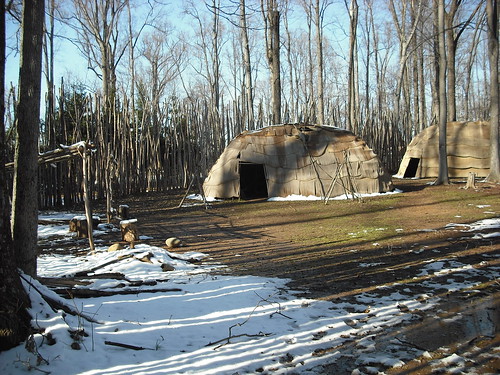
This is the Powhatan village where we interpret the Native Americans who lived in Virginia 400 years ago. Arrohateck (the name of this particular village) is mostly used for school programs.

Walking from Arrohateck, you enter into the English village. The first place you'll see is 1611, the Court de Guard, where sergeants of the guard would spend their time in the fort at Henricus.
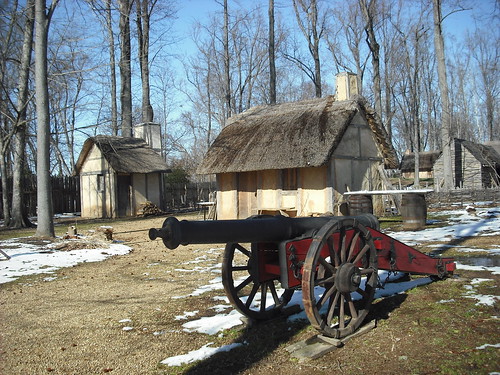
Up the road from the Court de Guard is the trades area. Here we have the Citie barn, which is where our carpentry shop is located. There is also our working blacksmith's forge where the blacksmith and his apprentice work.
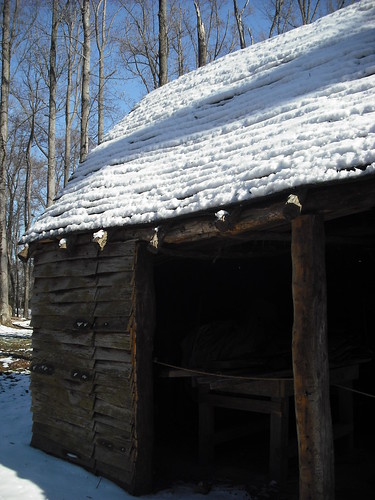

As you leave the trades area, the road takes you past the tavern, which we use for school programs and events. It is modeled after the 1640s Ordinary at St. Mary's City.
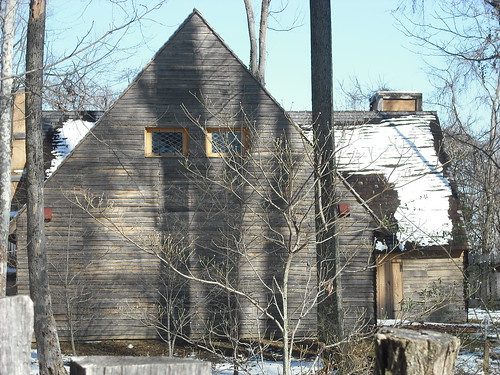
The original "Mount Malado" was built on a hill over looking the James around 1614. It would have served as a guesthouse for colonists just arriving to Virginia, but it is credited as being the first English hospital. Our recreation of Mount Malado is a lot smaller than the original, which would have had 80 beds and five fire places.
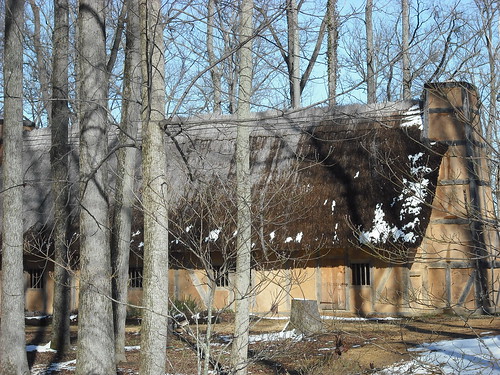

The next building being constructed at Henricus Historical Park is "Rocke Hall". This was the parsonage for Reverend Alexander Whitaker. Right now, it looks like a swimming pool, but that is the foundation for what will be a really cool two story structure once it is finished.

Following the path from Mount Malado and Rocke Hall, you'll come across the tobacco plantation. This represents a farm from the 1620s. We don't have a lot of animals living there right now - just chickens. The barn is solely for tobacco. The house is a typical dwelling of a yeoman farmer.
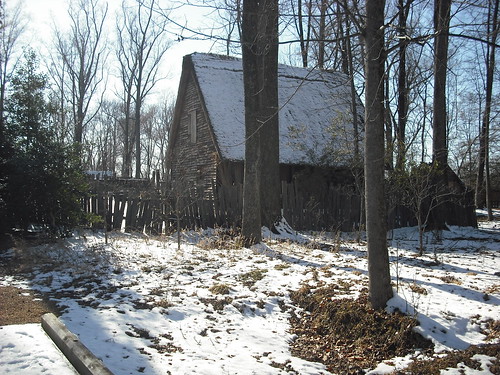
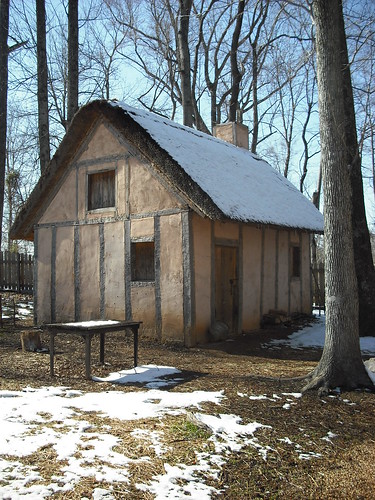

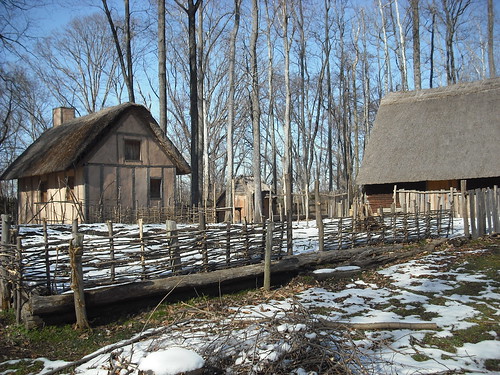
I'll go into more detail on the buildings in a later post, but that's the basic tour around the buildings. I hope you enjoyed seeing Henricus in the snow!
Stay tuned!
Jenny
Historical Interpreter, Domestic Skills
Henricus Historical Park is a 32 acre living history museum located along the James River, just south of Richmond. We have a dedicated group of interpreters and volunteers who portray the daily lives of English soldiers, tradesmen, indentured servants, the goodwives & single women, and Native Americans who lived in the areas of Coxendale and Henrico between the years 1611 to 1622. To do that, we have 13 structures on site, in which we interpret the 17th century. We perform the activities and chores, wear the same types of clothing, and eat the same meals they may have done 400 years ago.
As interpreters, we use "encounter third-person interpretation" to speak to visitors. So if you were to speak to us, we'd speak to you from a modern perspective. But for special occasions, we might break out the character interpretation. :)
To give you a glance around the site, I thought I'd post a few pictures. We had a rare occurrence on Monday: 4" of snow! (More about that later!) I hope you enjoy a look at the Henricus buildings in the snow...

This is the Powhatan village where we interpret the Native Americans who lived in Virginia 400 years ago. Arrohateck (the name of this particular village) is mostly used for school programs.

Walking from Arrohateck, you enter into the English village. The first place you'll see is 1611, the Court de Guard, where sergeants of the guard would spend their time in the fort at Henricus.

Up the road from the Court de Guard is the trades area. Here we have the Citie barn, which is where our carpentry shop is located. There is also our working blacksmith's forge where the blacksmith and his apprentice work.


As you leave the trades area, the road takes you past the tavern, which we use for school programs and events. It is modeled after the 1640s Ordinary at St. Mary's City.

The original "Mount Malado" was built on a hill over looking the James around 1614. It would have served as a guesthouse for colonists just arriving to Virginia, but it is credited as being the first English hospital. Our recreation of Mount Malado is a lot smaller than the original, which would have had 80 beds and five fire places.


The next building being constructed at Henricus Historical Park is "Rocke Hall". This was the parsonage for Reverend Alexander Whitaker. Right now, it looks like a swimming pool, but that is the foundation for what will be a really cool two story structure once it is finished.

Following the path from Mount Malado and Rocke Hall, you'll come across the tobacco plantation. This represents a farm from the 1620s. We don't have a lot of animals living there right now - just chickens. The barn is solely for tobacco. The house is a typical dwelling of a yeoman farmer.




I'll go into more detail on the buildings in a later post, but that's the basic tour around the buildings. I hope you enjoyed seeing Henricus in the snow!
Stay tuned!
Jenny
Historical Interpreter, Domestic Skills
Labels:
17th century,
buildings,
henricus,
interpretation,
introduction
Subscribe to:
Posts (Atom)




